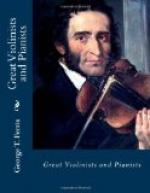One of the most remarkable of the great piano-forte virtuosos was unquestionably Sigismond Thalberg, an artist who made a profound sensation in two hemispheres, and filled a large space in the musical world for more than forty-five years. Originally a disciple of the Viennese school of piano-forte playing, a pupil of Mosche-les, and a rigid believer in making the instrument which was the medium of his talent sufficient unto itself, wholly indifferent to the daring and boundless ambition which made his great rival, Franz Liszt, pile Pelion on Ossa in his grasp after new effects, Thalberg developed virtuoso-ism to its extreme degree by a mechanical dexterity which was perhaps unrivaled. But the fingers can not express more than rests in the heart and brain to give to their skill, and Thalberg, with all his immense talent, seems to have lacked the divine spark of genius. It goes without saying, to those who are familiar with the current cant of criticism, that the word genius is often applied in a very loose and misleading manner. But, in all estimates of art and artists, where there are two clearly defined factors, imagination or formative power and technical dexterity, it would seem that there should not be any error in deciding on the propriety of such a word as a measure of the quality of an artist’s gifts. The lack of the creative impulse could not be mistaken in Thalberg’s work, whether as player or composer. But the ability to execute all that came within the scope of his sympathies or intelligence was so prodigious that the world was easily dazzled into forgetting his deficiencies in the loftier regions of art. Trifles are often very significant. What, for example, could more vividly portray an artist’s tendencies than the description of Thalberg by Moscheles, who knew him more thoroughly than any other contemporary, and felt a keener sympathy with his genre as an artist than with the more striking originality of Chopin and Liszt. Moscheles writes:
“I find his introduction of harp effects on the piano quite original. His theme, which lies in the middle part, is brought out clearly in relief with an accompaniment of complicated arpeggios which reminds me of a harp. The audience is amazed. He himself sits immovably calm; his whole bearing as he sits at the piano is soldierlike; his lips are tightly compressed and his coat buttoned closely. He told me he acquired this attitude of self-control by smoking a Turkish pipe while practicing his piano-forte exercises: the length of the tube was so calculated as to keep him erect and motionless.” This exact discipline and mechanism were not merely matters of technical culture; they were the logical outcome of the man and surely a part of himself. But within his limits, fixed as these were, Thalberg was so great that he must be conceded to be one of the most striking and brilliant figures of an age fecund in fine artists.




